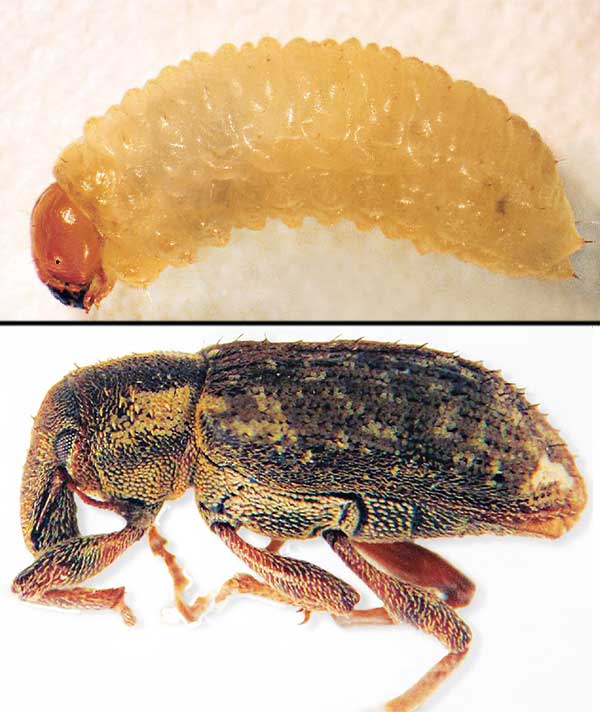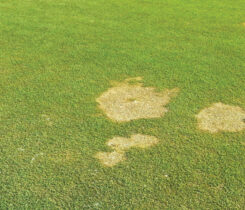Update on the lesser of two weevils

Annual bluegrass weevils lay their eggs in annual bluegrass, resulting in damage from larvae (top). (Photo: Ben McGraw)
Adult annual bluegrass weevils (Listronotus maculicollis; ABWs) are a common turfgrass pest that prefers to lay eggs on annual bluegrass (Poa annua L.) over creeping bentgrass (Agrostis stolonifera L.). We thought that allowing some damage from ABW larvae in creeping bentgrass fairways would reduce annual bluegrass cover throughout the season.
The effect of ABW damage was tested alone and in combination with various rates of paclobutrazol. From April to November in 2018 and 2019, we experimented at the Rutgers University on a simulated fairway consisting of creeping bentgrass and annual bluegrass. Paclobutrazol was applied monthly at 0, 4, 6 and 12 fluid ounces per acre across three insecticide programs (preventive, threshold and no insecticide).
The preventive insecticide program was an industry-standard program designed to provide commercially acceptable ABW control. In the threshold program, we did not apply insecticides until visual ratings determined that ABWs caused unacceptable turfgrass quality. The no-insecticide treatment did not receive any applications.
We visually evaluated annual bluegrass cover each month. In the absence of paclobutrazol, the preventive insecticide program resulted in 82 percent greater annual bluegrass cover than the threshold (67 percent) and no-insecticide programs (56 percent) by November 2018. Paclobutrazol at 6 ounces per acre resulted in 33 percent more annual bluegrass cover for the preventive program than the threshold (13 percent) and no-insecticide programs (8 percent). There were no differences between insecticide programs treated with 4 or 12 fluid ounces of paclobutrazol per acre.
In 2019, non-paclobutrazol-treated plots had more annual bluegrass cover (26 percent) than all paclobutrazol treatments (13 to 19 percent). The preventive insecticide program had 23 percent more annual bluegrass cover than the no-insecticide program (13 percent) by August 2019.
Katherine H. Diehl, Matthew T. Elmore, Ph.D., James A. Murphy, Ph.D., and Albrecht M. Koppenhöfer, Ph.D., are turfgrass scientists at Rutgers University. Olga S. Kostromytska, Ph.D., is at the University of Massachusetts. You may reach Koppenhofer at a.koppenhofer@rutgers.edu.












